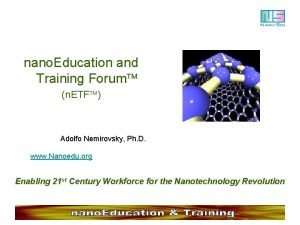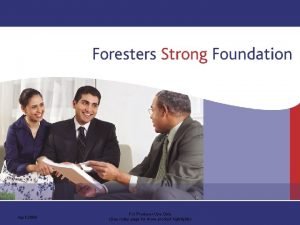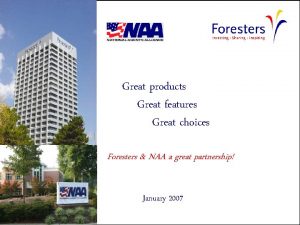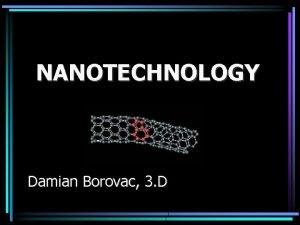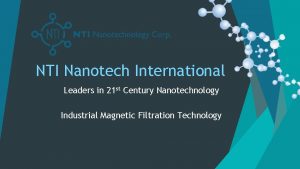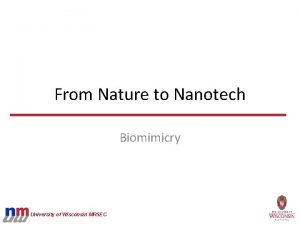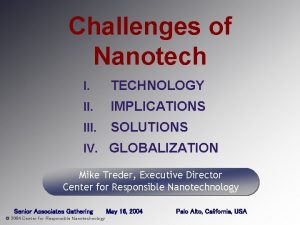www fpinnovations ca Nanotech 101 for Foresters What










































- Slides: 42

www. fpinnovations. ca “Nanotech 101” for Foresters – What does the future hold? Jim Dangerfield Executive Vice Alberta Professional Foresters 21 st Annual General Meeting

NSF Expert Panel “The effect of nanotechnology on the health, wealth and standard of living for people in this century could be at least as significant as the combined influences of microelectronics, medical imaging, computer aided engineering and man-made polymers developed in the past century”.

What is a Nanometer? Mountain 1 km 1000 m 0. 001 km = 1 m Child 1 m Ant 1 mm 0. 001 m 1, 000 mm = 1 m Bacteria 1 µm 0. 000001 m 1, 000 µm = 1 m Sugar Molecule 1 nm 0. 00001 m 1, 000, 000 nm = 1 m

Origins of Nanotechnology?

Nanotechnology in Nature

Optical Efficiency in ultra-thin Structures and Nanocellulose

Nanotechnology in Art

Buckminster Fullerene – C 60

Nanotubes

Nanotubes

Nanoropes

Is the nano-world different? The nanoworld Classical Mechanics (Everyday Physics) Quantum Mechanics (Wave Physics) 0. 1 1 10 100 Length Scale (nm) 1000

Nano changes physical properties Me ltin gp oin t - 10 64 C

Nano changes colour Bulk Gold = Yellow Nanogold = Red

Nano changes colour

Nano changes opacity

Nano changes opacity

Nano changes adherence

Nano changes strength

Nano changes strength Properties of Cellulose Nanofibrils Relative to Metallic and Polymeric Materials MATERIAL Tensile Strength (MPa) Elasticity Modulus (GPa) 10 000 150 1280 210 Aluminium alloys 380 and LM 6 b 330 71 Zirconiac 240 150 Cellulose nanofibrils 302 Stainless steela Aluminium with 20% particulate Si. Cd 121 593 Low-density polyethylenee 9 0. 25 Nylon 6/6 30% glass filledd 186 9 0/90/ ± 45 carbon in epoxyf 503 65

Nano changes porosity

Nano kills cancer Cell light + Cell death Nanoshell BNC Closeup of nanoshell binding to carcinoma surface oncoproteins Carcinoma cells Nanoshell BNCs + near IR light = Carcinoma cell death Tumor capillary “Leaky” endothelium

Nano in the everyday world

Using the Forest Resource in New Ways Over 1. 5 Trillion Tonnes/Year Cellulose

Origin of Forest Sector Nanotechnology crystalline region microfibril : amorphous region acid hydrolysis H 2 SO 4 TEM image of cotton nanocrystals

Using the Forest Resource in New Ways Nanocrystalline Cellulose Smallest physical subunit of cellulose Crystallite dimensions, 200 nm long, 10 nm wide

NCC Extraction • Any cellulose source can be used • Separated fines or vessel elements could be converted to a high value NCC stream • The hydrolyzate can be used as a sugar source for ethanol production

Native Cellulose Nano. Crystals Species Diameter Length SW 1 3 -5 180 +/- 75 HW 2 5 150 +/- 65 Tunicate 2 10 -20 100 - 2000 Valonia 2 10 - 20 > 1000 Cotton 1 7 100 - 300 Bacteria 2 5 -10 X 30 -50 100 - 2000 Algae > 20 2000 1. Gray, Chem Eur, 2001. 2. Gray, Biomac, 2005.

Nano changes physical properties 1% 5% 7% 100%

Nano changes adherence Gecko NCC

Nano changes colour

Nano changes colour

Achieved: Mixed NCC suspensions Only 2 NCC suspensions are needed to generate any intermediate colour Targeted applications: • cosmetics • ink • coloured films on solid support

Using the Forest Resource in New Ways Nanocrystalline Cellulose Achieved: Strong flexible films with tunable colour

Using the Forest Resource in New Ways With Nanocrystalline cellulose : A new highly filled “paper” sheet NCC layer density: 1. 6 g/cm 3 glossy and iridescent glossy, white Nanoclay RMS roughness=2. 1 nm 50% NCC+50% nanoclay, NCC side Gloss: 75. 2% Nanoclay layer density: 2. 6 g/cm 3 RMS roughness=24. 7 nm 50% NCC+50% nanoclay, Nanoclay side Gloss: 42. 5%

NCC in paints • NCC forms natural flakes • Mica flakes are used in paints • Mica flakes sell for $8000/t • P&G interested in replacing mica flakes with NCC

Using the Forest Resource in New Ways Enhancing wood properties using nanotechnology A surface hardening process • Surface hardness improved up to 40% • Will maintain the current product price level for the next 5 years Plasma technologies for Wood Products present potential for new properties • Outdoor uses • Non-Residential applications • Cutting tools Hydrophobic wood surface

Mechanical Properties Material Tensile strength GPa Modulus GPa cellulose crystal 7. 51 1452 Glass fiber 4. 8 86 Aluminum wire 0. 62 73 Steel wire 4. 1 207 Graphite whisker 21 410 11 -63 270 -970 Carbon nanotubes 3 1. 2. 3. Marks, Cell wall mechanics of tracheids 1967 Sturcova, et al. (2005) Biomacromol. 6, 1055 Yu, et al Science (2000) 287, 637

Using the Forest Resource in New Ways Combining Carbon Nanotubes with Nanocrystalline Cellulose? Carbon nanotubes (CNTs) are used in baseball bats, tennis racquets, and some car parts because of their greater mechanical strength at less weight per unit volume than that of conventional materials. Electronic properties of CNTs have made them a candidate for flat panel displays in TVs, batteries, and other electronics. Nanotubes for various uses can be made of materials other than carbon.

Using the Forest Resource in New Ways Combining Carbon Nanotubes with Nanocrystalline Cellulose?

Save the Planet – Grow More Trees – Use More Wood Thank You

www. fpinnovations. ca
 Nanotech etf
Nanotech etf Foresters funeral fund
Foresters funeral fund Foresters strong foundation brochure
Foresters strong foundation brochure Personlig tidbok för yrkesförare
Personlig tidbok för yrkesförare Rutin för avvikelsehantering
Rutin för avvikelsehantering Var finns arvsanlagen
Var finns arvsanlagen Programskede byggprocessen
Programskede byggprocessen Fspos vägledning för kontinuitetshantering
Fspos vägledning för kontinuitetshantering Myndigheten för delaktighet
Myndigheten för delaktighet Presentera för publik crossboss
Presentera för publik crossboss Kung dog 1611
Kung dog 1611 Debatt artikel mall
Debatt artikel mall Tobinskatten för och nackdelar
Tobinskatten för och nackdelar Tack för att ni har lyssnat
Tack för att ni har lyssnat Tack för att ni lyssnade bild
Tack för att ni lyssnade bild Referat mall
Referat mall Frger
Frger Mjälthilus
Mjälthilus Varför kallas perioden 1918-1939 för mellankrigstiden
Varför kallas perioden 1918-1939 för mellankrigstiden Rådet för byggkompetens
Rådet för byggkompetens Arkimedes princip formel
Arkimedes princip formel Avrunda decimaltal
Avrunda decimaltal Elektronik för barn
Elektronik för barn Borra hål för knoppar
Borra hål för knoppar Sura för anatom
Sura för anatom Smärtskolan kunskap för livet
Smärtskolan kunskap för livet Bris för vuxna
Bris för vuxna Argument för teckenspråk som minoritetsspråk
Argument för teckenspråk som minoritetsspråk Novell typiska drag
Novell typiska drag Trög för kemist
Trög för kemist Delegerande ledarstil
Delegerande ledarstil Humanitr
Humanitr Toppslätskivling effekt
Toppslätskivling effekt Steg för steg rita
Steg för steg rita Redogör för vad psykologi är
Redogör för vad psykologi är Lek med geometriska former
Lek med geometriska former Claes martinsson
Claes martinsson En lathund för arbete med kontinuitetshantering
En lathund för arbete med kontinuitetshantering Mat för unga idrottare
Mat för unga idrottare Etik och ledarskap etisk kod för chefer
Etik och ledarskap etisk kod för chefer Offentlig förvaltning
Offentlig förvaltning Lyrik lyra
Lyrik lyra Plagg i rom
Plagg i rom
